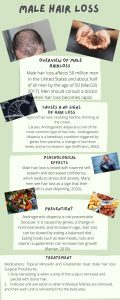Morgan Johnson
Introduction
Male hair loss affects 50 million men in the United States and about half of all men by 50 (MacGill, 2017). Hair loss affects women as well but is seen more in men. As men get older, their hormone levels change and genes are triggered to contribute to hair loss. With the proper knowledge of the hair loss factors, psychological effects, and treatment methods, men can deal with it
Causes and Signs of Hair Loss

Some signs of male hair loss include excessive shedding and receding hairline. At the temple, the hair starts to thin as well as occurs at the top and the back of the head. One of the most common types of thinning in regards to hair loss is the receding hairline. A receding hairline is when the hair starts to thin and move towards the back of the head. A receding hairline is noticeable because the hairline begins to make an M shape. Hair loss at the top of the head, also known as the crown, gradually happens over time. One will notice that the hair is starting to thin out at the crown until it eventually turns bald (Jewell, 2020).
Androgenetic alopecia is the “most common types of hair loss in men” that causes the symptoms previously stated and is a hereditary condition triggered by genes from parents, a change in hormone levels, and age (Hoffmann, 2002). It is found that “androgenetic alopecia may affect up to 70% of men and 40% of women, generally at some point in their lifetime” (McElwee & Shapiro, 2012). It is a genetically influenced hair loss that causes a gradual change of the terminal hair into vellus hair , it is also characterized with increased shedding (Rathnayake & Sinclair, 2010).
Psychological Effects
Hair loss has a psychological effect on men because they find themselves less attractive and older looking. Many men see hair loss as a sign that their youth is over, and they no longer have control over their physical appearance. Hair loss can lead to a failed relationship because of a decrease in men’s self-esteem and attractiveness. There have even been studies that have shown women to find men that are going through hair loss less attractive. When hair loss becomes more recognizable, it can lead to social avoidance instances; meaning, men will avoid being seen in public because of hair loss, which can lead to depression (Hall, 2019). Male hair loss has been linked with “lowered self-esteem and decreased confidence”, which also leads to stress and anxiety (Manning, 2020).
Can Male Hair Loss Be Prevented?

Although androgenetic alopecia is not preventable because it is caused by genes, hormone level changes, and age, there are a few ways to slow hair loss progression. Men can slow hair loss progression and even increase hair growth is by eating a balanced diet. Some foods to incorporate into one’s diet should contain lean protein. Lean proteins, which support hair growth, include fish, lean meats, and soy. Nuts, such as walnuts and cashews, contain various nutrients (i.e. vitamin E, B vitamins, and zinc) that promote hair growth (Raman, 2018). Another way men can slow hair loss is to manage stress by practicing deep breathing techniques, engaging in physical activity, and talking to friends, family, doctors, or therapists about the problems causing stress (Ratini, 2019).
Treatment Options
Medications
Topical Minoxidil was once used to treat high blood pressure in the 1960s but was later discovered to promote hair growth. The FDA approved topical Minoxidil to treat male androgenetic alopecia in 1984 (Rathnayake & Sinclair, 2010). Finasteride is a medication that is also used to treat male pattern hair loss. This medication decreases the amount of dihydrotestosterone (DHT). DHT is a hormone produced by the body that contributes to the development of male characteristics and can cause baldness (Rathnayake & Sinclair, 2010).
Procedures
Another treatment method includes hair transplantation, one of the most rapidly evolving cosmetic surgery (Khanna, 2008). In 1995 follicular unit transplantation was introduced, by which hair can be transplanted in small units. In follicular unit transplantation, the hair can be implanted in two ways: strip harvesting and follicular unit extraction. Strip harvesting is when a strip of the occipital scalp is removed, and the donor’s hair is separated into units and transplanted into the balding areas. Follicular unit extraction is when individual follicles of occipital hair are removed, and then each unit is reinserted into the bald area with a microblade. This technique is better than strip harvesting because it leaves no visible scars and takes less time to heal (Rathnayake & Sinclair, 2010). Many surgeons report that follicular unit extraction has a success rate of “more than 90 percent” (Khorsandi, 2020).
Conclusion
Overall, male hair loss is an ongoing issue in males and has many contributing factors such as age, hormones, and genetics. Androgenetic alopecia is the most common type of hair loss triggered by genetics, age, and hormones. Even though androgenetic alopecia can not be prevented, hair loss progression can be slowed by eating a balanced diet as well as reducing stress. Treatment for hair loss has evolved, because of new discoveries in medicine, and cosmetic surgical procedures.

Chapter Review Questions
1. The most common type of hair loss in men is?
A. The receding hairline
B. Androgenetic alopecia
C. Hair loss at the crown
D. Hair loss at the temple
2. Which of the following is not triggered by androgenetic alopecia?
A. Genes
B. Stress
C. Hormones
D. Age
3. Finasteride is a medication that ______ the amount of dihydrotestosterone
A. Increases
B. Decreases
C. Maintains
D. Eliminates
References
Dresden, D. (2019, April 12). What are the best foods for healthy hair growth? Medical News Today. https://www.medicalnewstoday.com/articles/324949.
Hall, K. (2019, June 07). The psychological impact of male hair loss. Hims. https://www.forhims.com/blog/the-psychological-impact-of-male-hair-loss
Hoffmann, R. (2002). Male androgenetic alopecia. Clinical and Experimental Dermatology, 27(5),373-382. https://doi.org/10.1046/j.1365-2230.2002.01086.x
Jewell, T. (2020, January 6). Early signs of balding in men and women. Healthline. https://www.healthline.com/health/beauty-skin-care/signs-of-balding.
Khanna, M. (2008). Hair transplantation surgery. Indian Journal of Plastic Surgery: Official Publication of the Association of Plastic Surgeons of India, 41(Suppl), S56-S63. https://www.ncbi.nlm.nih.gov/pmc/articles/PMC2825128/
Khorsandi, D. C. (2020, January 21). What’s the success rate of FUE hair restoration? Plastic Surgery Las Vegas, NV. https://vipplasticsurgery.com/blogs/whats-the-success-rate-of-fue-hair-restoration#:~:text=Most%20reputable%20surgeons%20report%20FUE,thinning%20hair%20or%20hair%20loss.
MacGill, M. (2017, July 28). Male pattern baldness: Causes and treatment. Medical news today. https://www.medicalnewstoday.com/articles/68077#causes.
Manning, M. (2020, November 18). How hair loss in men affects self-esteem. WebMD. https://www.webmd.com/connect-to-care/hair-loss/how-hair-loss-in-men-affects-self-esteem.
McElwee, K., & Shapiro, J. (2012). Promising therapies for treating and/or preventing androgenic alopecia. Skin Therapy Letter, 17(6), 1-4. https://www.researchgate.net/publication/228070384_Promising_therapies_for_treating_andor_preventing_androgenic_alopecia
Raman, R. (2018, April 9). The 14 best foods for hair growth. Healthline. https://www.healthline.com/nutrition/foods-for-hair-growth
Rathnayake, D., & Sinclair, R. (2010). Male androgenetic alopecia. Expert Opinion on Pharmacotherapy, 11(8), 1295-1304. 10.1517/14656561003752730
Ratini, M. (2019, April 25). 10 tips to manage stress. WebMD. https://www.webmd.com/balance/guide/tips-to-control-stress
a genetic condition that causes hair loss
Thick, long, pigmented hair found on the scalp, face, armpits, and pubic area
fine, wispy hair that covers most of the body. It develops in childhood and remains on much of the body throughout adulthood
Pertaining to the occiput, the back of head.
